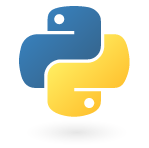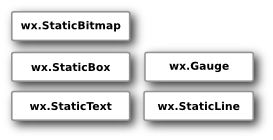Introduction to wxPython
An application is a computer program that performs a specific task or a group of tasks. Web browser, media player, word processor are examples of typical applications. A term tool or utility is used for a rather small and simple application that performs a single task. A unix cp program is an example of a such a tool. All these together form computer software. Computer software is the broadest term used to describe the operating system, data, computer programs, applications, mp3 files or computer games. Applications can be created for four different areas.
Programming languages
There are currently several widely used programming languages. The following list is based on the TIOBE Programming Community Index. The numbers are from November 2010.| Position | Language | Ratings |
|---|---|---|
| 1 | Java | 18.5% |
| 2 | C | 16.7% |
| 3 | C++ | 9.5% |
| 4 | PHP | 7.8% |
| 5 | C# | 5.7% |
| 6 | Python | 5.7% |
| 7 | Visual Basic | 5.5% |
| 8 | Objective C | 3.2% |
| 9 | Perl | 2.4% |
| 10 | Ruby | 1.9% |
PHP dominates over the Web. While Java is used mainly by large organizations, PHP is used by smaller companies and individuals. PHP is used to create dynamic web applications.
C# is the main programming language of the Microsoft .NET platform. C# is followed in .NET by Visual Basic. It represents of the popularity of the RAD. (Rapid Application Development.)
Perl, Python and Ruby are the most widely used scripting languages. They share many similarities. They are close competitors.
The Objective C is the main programming language of the Apple ecosystem.
Python
 Python is a successful scripting language. It was initially developed by Guido van Rossum. It was first released in 1991. Python was inspired by ABC and Haskell programming languages. Python is a high level, general purpose, multiplatform, interpreted language. Some prefer to call it a dynamic language. It is easy to learn. Python is a minimalistic language. One of its most visible features is that it does not use semicolons nor brackets. Python uses indentation instead. Today Python is maintained by a large group of volunteers worldwide.
Python is a successful scripting language. It was initially developed by Guido van Rossum. It was first released in 1991. Python was inspired by ABC and Haskell programming languages. Python is a high level, general purpose, multiplatform, interpreted language. Some prefer to call it a dynamic language. It is easy to learn. Python is a minimalistic language. One of its most visible features is that it does not use semicolons nor brackets. Python uses indentation instead. Today Python is maintained by a large group of volunteers worldwide. For creating graphical user interfaces, python programmers can choose among three decent options. PyGTK, wxPython and PyQt.
wxPython
wxPython is a cross platform toolkit for creating desktop GUI applications. The principal author of wxPython is Robin Dunn. With wxPython developers can create applications on Windows, Mac and on various Unix systems. wxPython is a wrapper around wxWidgets, which is a mature cross platform C++ library. wxPython consists of the five basic modules.
wxPython API
wxPython API is a set of methods and objects. Widgets are essential building blocks of a GUI application. Under Windows widgets are calles controls. We can roughly divide programmers into two groups. They code applications or libraries. In our case, wxPython is a library that is used by application programmers to code applications. Technically, wxPython is a wrapper over a C++ GUI API called wxWidgets. So it is not a native API. e.g. not written directly in Python.In wxPython we have lots of widgets. These can be divided into some logical groups.
Base Widgets
These widgets provide basic functionality for derived widgets. They are called ancestors. They are usually not used directly.
Top level Widgets
These widgets exist independently of each other.
Containers
Containers contain other widgets.
Dynamic Widgets
These widgets can be edited by users.
Static Widgets
These widgets display information. They cannot be edited by user.
Other Widgets
These widgets implement statusbar, toolbar and menubar in an application.
Inheritance
There is a specific relation among widgets in wxPython. This relation is developed by inheritance. The inheritance is a crucial part of the object oriented programming. Widgets form a hierarchy. Widgets can inherit functionality from other widgets. Existing classes are called base classes, parents, or ancestors. The widgets that inherit we call derived widgets, child widgets or descendants. The terminology is borrowed from biology.
Inheritance of a button
Say we use a button widget in our application. The button widget inherits from 4 different base classes. The closest class is the wx.Control class. A button widget is a kind of a small window. All widgets that appear on the screen are windows. Therefore they inherit from wx.Window class. There are objects that are invisible. Examples are sizers, device context or locale object. There are also classes that are visible but they are not windows. For example a color object, caret object or a cursor object. Not all widgets are controls. For example wx.Dialog is not a kind of control. The controls are widgets that are placed on other widgets called containers. That's why we have a separate wx.Control base class. Every window can react to events. So does the button widget. By clicking on the button, we launch the wx.EVT_COMMAND_BUTTON_CLICKED event. The button widget inherits the wx.EvtHandler via the wx.Window class. Each widget that reacts to events must inherit from wx.EvtHandler class. Finally all objects inherit from wx.Object class. This is the Eve, mother of all objects in wxPython.
This was an introduction to wxPython.
No comments:
Post a Comment